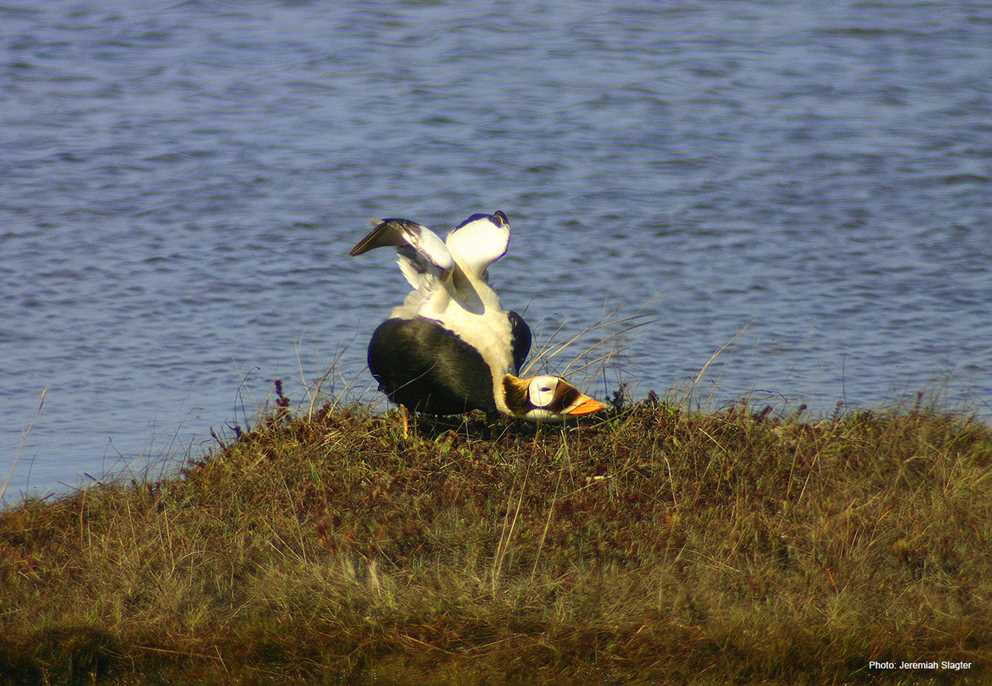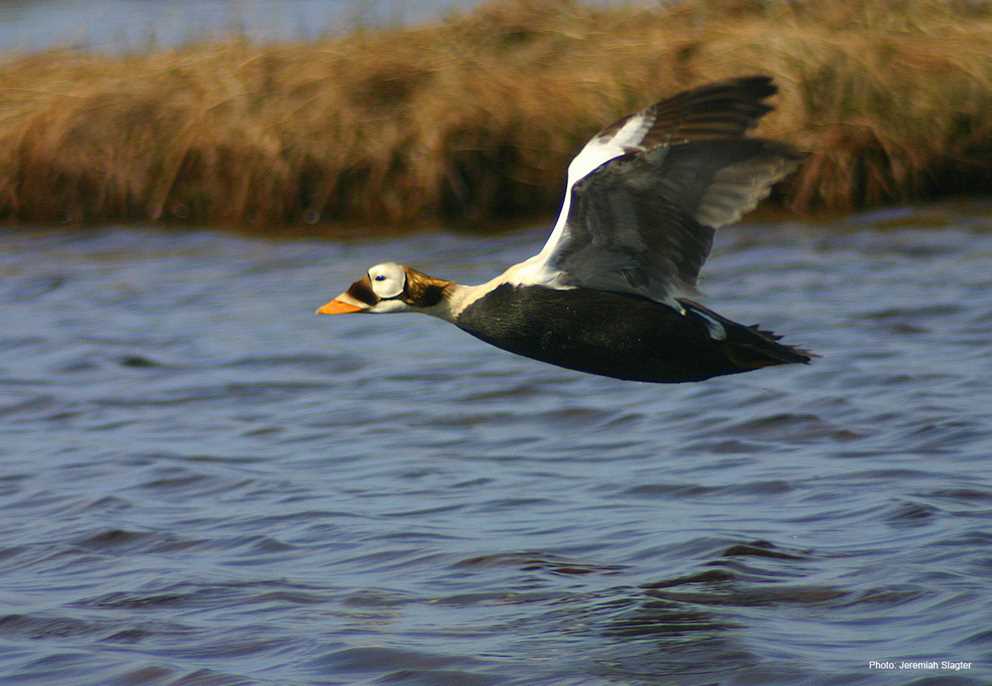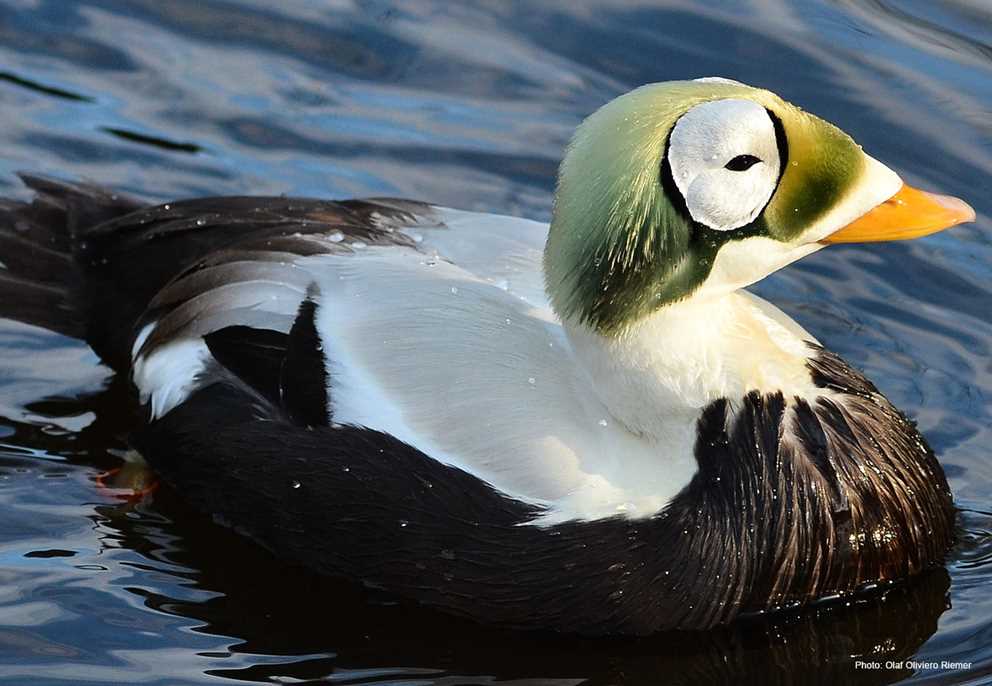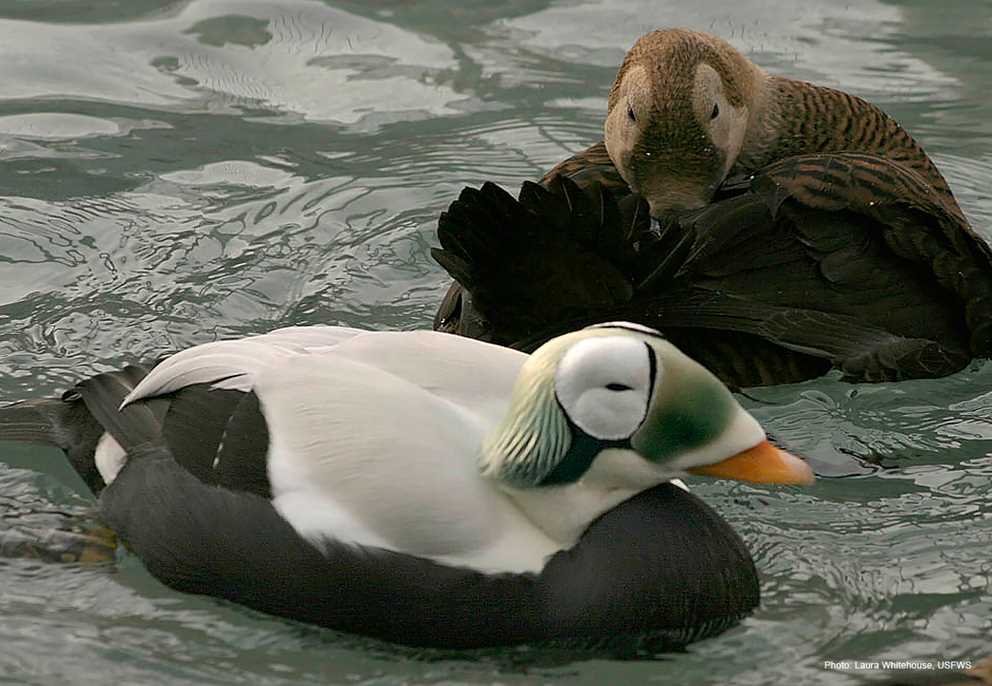Overview
The Spectacled Eider is a medium to large sea duck, with three disjunct breeding populations—two in Alaska (Yukon-Kuskokwim Delta and Arctic Coastal Plain) and one in Arctic Russia. They spend winter within the pack ice of the Bering Sea southwest of St. Lawrence Island, Alaska. Adult males have a light-green head, large white-silver eye patches (spectacles), and an orange bill. The back is white while underparts are black, with a large white/cream area on the upper and middle coverts of the wing and long curved white tertial feathers. Females are cinnamon brown. In flight, males show a large patch of white on the upper and middle coverts on a grayish-black wing. Females show brown wings with a lighter brown patch on the upper and middle coverts.
Prefers shallow tundra wetlands for nesting, and winters among pack ice in the Bering Sea in areas of up to 250 feet in depth.
Description
Key Identification Features
- In flight, the male Spectacled Eider shows a conspicuous white/cream patch associated with upper wing and middle coverts, the female wing is mottled brown with a lighter brown or buff patch on the upper and middle coverts.
- The male has a green head with a large circular white patch surrounding the eye (spectacles), and a white neck and chin, with an orange bill. The back is white and may show long, curved white scapular feathers. The sides, breast, rump, and vent are black.
- Females are mottled brown overall, may have a light buffy circular patch around the eye (spectacles), and lighter brown patch on upper and middle coverts of the wing.
Male/Female Average Length and Weight
- Weight: Male 3.2–3.7 lbs.; Female 3.2–3.4 lbs.
- Wingspan: 33 in.
Male Identification
- Alternate (Breeding) Plumage: Adult males have a light green head, large silver-white eye patches (spectacles), and an orange bill. The back is white, while underparts are black, and there is a large white/cream area on the upper and middle coverts of the wing and long, curved white tertial feathers. In flight, males show a large patch of white on their upper and middle coverts on a grayish-black wing.
- Basic Plumage: Dull brown-olive, bill dull gray, light gray nail. A cryptic plumage attained in summer (typically July/August) while birds are molting flight feathers.
Female Identification
- Alternate and Basic Plumage: Similar to each other, females are cinnamon brown with presence of darker barring. Females show brown wings with a lighter brown patch on the upper and middle coverts.
In-Flight Identification
- Male: Male Spectacled Eiders show a conspicuous white/cream patch associated with upper wing and middle coverts.
- Female: The female wing is mottled brown with a lighter brown or buff patch on the upper and middle coverts.
Vocalizations
- Female Calls: Females may give a guttural croak alarm call, and a two-syllable clucking call to greet mates or gather broods.
Similar Species
- King Eider and Common Eider: Presence of the “spectacle” separates this species from slightly larger King Eider and much larger Common Eider. Unique looking birds, not easily confused with other species. However, hunters in the Yukon-Kuskokwim Delta, St. Lawrence Island, or North Slope of Alaska in particular should study the species carefully, and scrutinize ducks flying low over water, especially in low light conditions, to avoid illegally harvesting this threatened species.
Habitat Preferences
- Breeding: Spectacled Eiders breed in Arctic coastal tundra and inland tundra wetlands consisting of inter-connected ponds of assorted sizes.
- Migration and Wintering: During winter, they are found in water up to 250 feet deep offshore in the Bering Sea, southwest of St. Lawrence Island. This wintering area was unknown until marked birds were located in the early 1990s.
Foraging Habits and Diet
- Spectacled Eiders primarily forage on invertebrates throughout the annual cycle.
- Breeding Season: During spring and summer, they ingest aquatic insects, seeds, and aquatic vegetation.
- Migration and Winter: Clams and mussels are frequently consumed during winter.
Breeding Habits
- Monogamy: Spectacled Eiders are considered monogamous, but the duration of pair bonds, as well as where and when bonds are formed is unknown. One-year-old females are not known to nest, and only about half of two-year-old females nest. Most females nest at 3 years of age.
- Nest Locations: Nesting begins in June, often when ice cover is still present on ponds. Females create a nest bowl lined with grasses, sedges and lichens, and deposit down as laying progresses. Nests are located in close proximity to water on islands, peninsulas, or pond shorelines. Males depart nesting areas during incubation.
- Clutch Size: 5 to 6 eggs. The eggs are sub-elliptical to long oval, light olive-green, and are 2.7 by 1.8 in. The incubation period averages 24 days. Given their Arctic breeding range, Spectacled Eider nest initiation is typically from mid to late June, and they are not known to renest.
Migration and Distribution
- Fall Migration: Spectacled Eiders are poorly studied with respect to migration but depart breeding regions in June–July (males and unsuccessful females) or July–August (successful females) prior to freeze-up. Initial movements are to molting areas and subsequently to migration and winter areas. Arrival on migration and winter areas variable, beginning as early as August and continuing through October.
- Spring Migration: Spring migration influenced by timing of sea ice opening, usually arriving on Arctic nesting grounds in late May or early to mid-June.

Conservation Status
- IUCN Status: Near Threatened
- Population Status: There is an estimated global population of 110,000–125,000 birds. The global population has declined from 500,000 in the 1960s. The species occurs only in Alaska in North America and is listed as Threatened under the United States Endangered Species Act. The Alaska breeding population is estimated at 8,000 pairs, while 140,000 individual birds (as opposed to breeding pairs) were estimated in Russia.
- Conservation Concerns: Poorly studied, the causes of the long-term decline include high winter mortality of sub-adults, and ingestion of lead shot.
- Conservation Focus: Conservation efforts focus on reducing exposure to lead, oil, and predation in breeding areas, restricting harvest, understanding potential effects of changing environmental conditions and disease risks, and protecting habitat.
Harvest Information
- No harvest. Spectacled Eiders are listed as "Threatened" under the U.S. Endangered Species Act, and hunting this species is illegal.




